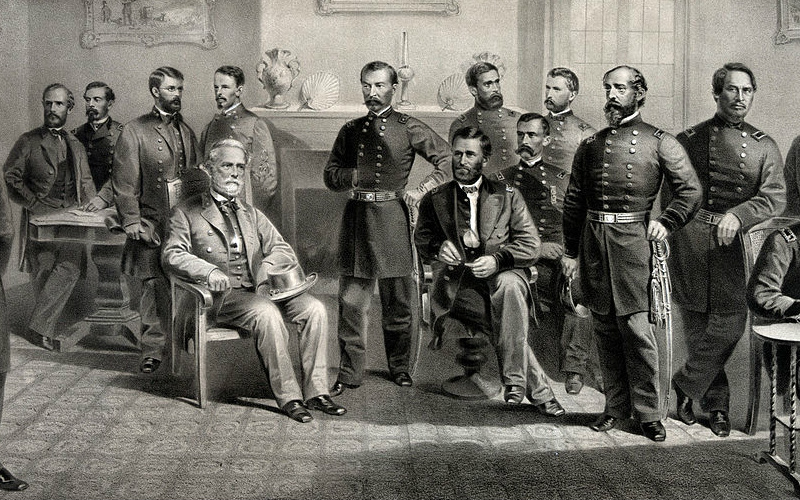(W)Archives: Memorializing the Most Important Surrender in American History

One hundred and fifty years ago yesterday, General Robert E. Lee surrendered his Confederate Army to General Ulysses S. Grant at Appomattox. The Civil War was effectively over as a living experience. It immediately transitioned into memory.
For some Americans, the Civil War is almost a non-event, a non-memory. I, for instance, grew up in the Seattle area. For me and my public school classmates, the Civil War was something that happened long ago, far away, and to other people. Today, however, I live in “occupied Virginia,” right outside Washington, DC. Here, as an adult, it becomes obvious that the Civil War is in many ways an ongoing event for many Americans, particularly those who see the Civil War as the brutal destruction of a noble way of life. The Sons of Confederate Veterans case now before the Supreme Court is just the latest evidence of this.
In this anniversary period, perhaps it is useful to strip away some of the accretions that cover the Civil War, and reflect on what it looked like and meant at the time. Accordingly, today we highlight two different recollections of Lee’s surrender found in documents held at the Library of Congress in Washington. The first is a drawing entitled “Genl. Lee leaving the McLean house after the surrender,” done by the renowned Civil War sketch artist Alfred R. Waud, who worked for Harper’s Weekly. On April 9, 1865 Waud patiently waited outside the McLean House, where the two generals were discussing the surrender. When Lee left, Waud swiftly drew what he saw. The inscription on the bottom, “Orderlies holding horses all about,” underlines the fact that he had time to capture only the most salient features of the scene for this first draft. Given the absence of photographers at this event, the sketch may be the closest thing to a true representation of it. In a later version of the drawing, Waud added in more orderlies and filled in background details. However sincere those additional details were, already recollection was starting to diverge from reality.
The second item is some sheet music also in the Library of Congress collection. In the 19th century, many American households had pianos, violins or other musical instruments, and these were often the centerpieces of an evening’s entertainment. Thus, sheet music occupied something like the cultural place that 45s did in the 20th century and mp3 files do today. Thus, even though it is odd to the modern eye, it is perfectly natural that the surrender at Appomattox should have promptly become the subject of a popular song and published sheet music. In 1867, a “Mrs. J. P. H.” from Virginia published “General Lee’s Surrender,” a “bittersweet waltz” as one 21st century musician has described it. The song’s lyrics were fairly straightforward but in them the storyline of a noble defeat is plainly evident. We see this in verses two and three, which read:
Bravely and well that noble heart
On many a hard won field had stood
Determined for their native land
Freely to give their heart’s best blood.
Twas vain! for an un-number’d host
Clos’d round our small heroic band
The General saw that hope was lost,
And sadly gave up his command.
Over the fifteen decades since the end of the Civil War, the “memory” of the war has become increasingly artificial given that nobody alive today has actual memories of the war. Broadly speaking, however, these “memories” fall into two categories: the realistic and the nostalgic. Those two types of memories were already visible in the 1860s as exemplified by the simple sketches of Waud and the unselfconscious romanticism of Mrs. J.P.H.
Mark Stout is a Senior Editor at War on the Rocks. He is the Director of the MA Program in Global Security Studies and the Graduate Certificate Program in Intelligence at Johns Hopkins University’s School of Arts and Sciences in Washington, D.C.

